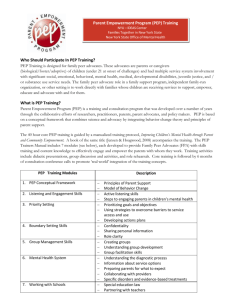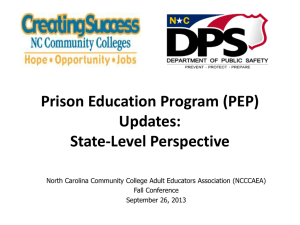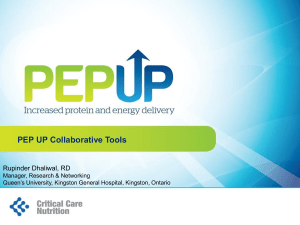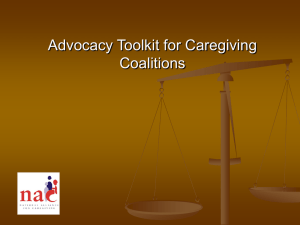Powerpoint Slides - National Technical Assistance Center for
advertisement
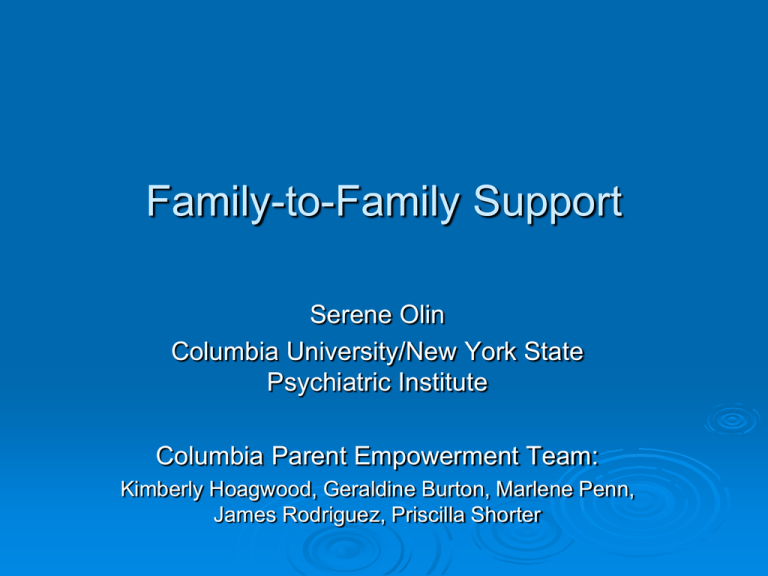
Family-to-Family Support Serene Olin Columbia University/New York State Psychiatric Institute Columbia Parent Empowerment Team: Kimberly Hoagwood, Geraldine Burton, Marlene Penn, James Rodriguez, Priscilla Shorter Outline Family-to-Family Support: Components and Research Findings (Hoagwood et al., 2010, Clinical Child and Family Psychology Review) Application of Theories of Change to Family-to-Family Support (Olin et al., 2009, Journal of Child and Family Studies) Implications for research and evaluation Evolving model: Family Peer Advocates in Children’s Mental Health Peer parents address stigma, isolation, distrust, and blame that many parents experience RWJ/MacArthur Fdn Survey: Documents increase in # of family organizations, parent membership nationally F2F grassroots education programs available for free for parents in NAMI, CHADD. 12,000 attended NAMI Basics in first year roll-out Workforce capacity shortages; new roles for family peer advocates Peer support billable for adults; billable for families of children in some states Goal of Review 1.To provide conceptual consistency in the definition of family support services 1.To identify core components of FS services 1.To examine various models of FS delivery, and 1.To assess the status of the research on the impact of family support services, and family to family services in particular. Family Support: Research Review & Synthesis (Hoagwood, Cavaleri, Olin, Burns, Slaton, Gruttadaro, Hughes, 2010) Over 200 family support interventions/programs with caregiver component were examined 50 met criteria for having Structured or formal curriculum Some evaluation data Focus on caregiver needs or well-being Definition of Family Support (a) Services or interventions directed parents or caregivers of children with mental health needs with the explicit purpose of helping caregivers clarify their own needs or concerns; (b) reduce their sense of isolation, stress, or self-blame; (c) provide education or information; (d) teach skills; and (e) empower and activate them, so that they can more effectively address the needs of their families. Family Support Components 1. Informational/Educational Support Education about child behavior/development, course of mental illness and its impact, treatment options, child and family service systems and other resources. 2. Instructional/Skills Development Support A. Coaching caregiver on effective ways to address their child’s illness or behaviors. B. Skill-building directed at addressing caregiver’s personal wellbeing (e.g., communication, problem-solving, crisis management, stress management skills) Family Support Components 3. Emotional and Affirmational Support Shared communication among families and/or between providers and families to promote caregiver’s feelings of being affirmed, understood and appreciated. 4. Instrumental Support Concrete services such as respite care, transportation, and flexible funds for emergencies. 5. Advocacy Support A. Provision of specific information about parental rights and resources (e.g., legislation, entitlements), coaching on ways to effectively negotiate for services, or provision of direct advocacy to obtain services for a caregiver or child. B. Leadership skill building to develop caregiver as an advocate at policy and service system levels. Comparison of Family Support Programs by Type of Support and Provider Type of Support Family Led (n=11) Clinician Led (n=33) Team Led (n=6) Total Programs (N=50) Information Education n=10 (91%) n=22 (44%) n=5 (83%) 37 (74%) Instructional/ Skills Development n=10 (91%) n=26 (79%) n=5 (83%) 41 (86%) Emotional n=6 (55%) n=10 (30%) n=6 (100%) 22 (44%) Instrumental n=3 (27%) n=0 n=3 (50%) 6 (12%) Advocacy n=11 (100%) n=7 (21%) n=5 (83%) 23 (46%) Key Findings Similar activities/functions across provider categories, but emphasis differed Clinicians focused on Family providers emphasized Skill building related to management of child symptoms Parent needs, in service of increasing parent capacity to support child treatment compliance Building skills to increase parents’ personal coping skills, respite, and self-care Cognitions or emotions about experiences with goal of problem-solving child management issues; Advocacy supports (more apt to recognize and discuss system level barriers than parent level barriers to service access/participation) Team Led providers were more comprehensive, with a more balanced emphasis across the different types of support What makes Family-to-Family Support Different? Credibility and trust: peer parents provide a role model to reduce isolation, sense of blame, and facilitate sense of empowerment Provides a linkage to community resources and services Assists parents in identifying their own needs and concerns Skill building focused on coping, self-care, crisis management, problem solving skills and other personal skill development Emotional support in the form of facilitated sharing of experiences and social connections to other parents Impact of Family Support Data on parent-to-parent services is limited; benefits found most consistently related to caregiver satisfaction Data from clinician-led models are most rigorous, and generally indicate caregiver support produces superior child outcomes compared to standard treatment Benefits found for parent mental health, parent selfefficacy, stress levels, and perceived social supports and skills; family functioning; treatment engagement and reduced barriers to care Training Family Peer Advocates: The Parent Empowerment (PEP) Model The Parent Empowerment (PEP) Model Background: Developed in collaboration with family advocates, researchers and policy-makers Goal: Better prepare family advocates to more effectively address the needs for families whose children have MH difficulties Training focus: Engagement skills Information/education Emotional support Advocacy support Facilitate integration in workforce, with emphasis on roles, boundaries, core competencies 14 The PEP Framework: A Model for Working with Families Principles of Family Support Parents as Agents of Change Model Goal: The overarching framework for PEP brings together what we know from the parent support field and behavioral science, and combines them into a model for working with parents. 15 Application of Behavioral Science Theories Decades of research have produced hundreds of studies on factors that influence actions and behaviors These studies rely on a small group of theories whose core elements have been expanded into a Unified Theory of Behavior (UTB) (Jaccard et al., 1999, 2002) UTB is conceptualized along 2 dimensions: a. Factors that motivate intentions (e.g., beliefs and expectations, attitudes, social norms, self-concept, affect and emotions) b. Factors that determine actions (e.g., intentions, knowledge, skills, environmental constraints, prior habits, priorities) 16 Adaptation of UTB Model Expected Value What do I get out of this? INTERVENTION STRATEGY Social Norms Should I do it? What will important others think? Attitudes/Affect How do I feel about it? Intention to Act Behavior/Acti on Self-Efficacy/Ability Can I do it, and do it well? Intervention Target Possible Barriers Skills/Knowledge, Habits, Environmental Obstacles, Priorities 17 PEP Conceptual Framework Goals Expected Value Does parent feel that the action will have direct impact for child/family? Parent Support … Family Peer Advocate STRATEGIES Social Norms What does parent think important others will think? What do other parents do? Attitudes/ Feelings/Beliefs Intentions Action How does the parent feel about MH, providers or systems, or the action? SelfEfficacy/Ability Does parent see self as competent or effective? Intervention Target Possible Barriers Is Individualized Facilitates Linkages Is Respectful and Culturally & Linguistically Competent 4. Builds Skill 5. Increases Knowledge 6. Is Engaging 7. Problem Solves 8. Focuses on Outcomes and Successes 9. Broadens Horizons 10. Promotes Advocacy 1. 2. 3. Skills/Knowledge, Habits, Environmental Obstacles, Priorities Framework: Application of PEP Parents as Change Agents Advocate Strategies: Provide information, teach skills, share experience, problem solve, model behavior What do I get out of this? What do important others think/do? How do I feel about mental illness? (Attitudes, Parent Goal: Understand my child’s behavior Intention to call MH agency Call MH agency beliefs, stigma, past experiences) Do I believe I know how to navigate the system? Intervention Target Possible Barriers Knowledge about disorder, service systems, skills to navigate system, obstacles, competing priorities Summary of PEP Model • Support Active Listening Skills to Give Parents A Voice and Get The Parents’ Story • Use “Principles of Parent Support” to Help Parents Set Priorities • • • Determine and prioritize parents’ needs/concerns Set realistic goals with parents Use “Parents as Agents of Change” to Make It Work • • • Determine action with parents Identify potential strategies to support parents (e.g., provide information, teach skills) Anticipate obstacles and problem solve 20 Implications of Research Review and PEP Model for Family-to-Family Services Data on impact of family-to-family support is limited Need to examine impact on outcomes for families (beyond parent satisfaction) Research synthesis delineates at least 5 identifiable components of family support PEP model provides a theory-driven approach to systematically identify points of leverage to improve impact of family support services Research on impact of family-to-family support is critical to lend greater legitimacy and sustainability of a critical and rapidly developing service in children’s MH

